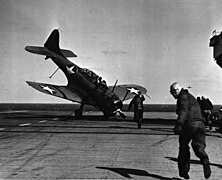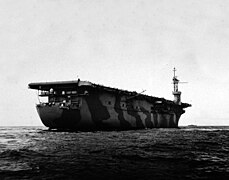USS Charger

| |
| History | |
|---|---|
| Name |
|
| Ordered | C3-P&C |
| Builder | Sun Shipbuilding & Drydock Co., Chester, Pennsylvania |
| Laid down | 19 January 1940 |
| Launched | 1 March 1941 |
| Acquired | 4 October 1941 |
| Commissioned | 3 March 1942 |
| Decommissioned | 15 March 1946 |
| Reclassified |
|
| Fate |
|
| General characteristics | |
| Class and type | Template:Sclass- |
| Displacement | 8,000 long tons (8,128 t) |
| Length | 492 ft (150 m) |
| Beam |
|
| Draft | 26 ft 3 in (8.00 m) |
| Speed | 17 knots (31 km/h; 20 mph) |
| Complement | 856 officers and enlisted |
| Armament |
|
| Aircraft carried | 30+ |
USS Charger (CVE-30) (originally BAVG-4, then AVG-30, then later ACV-30) was an escort carrier of the United States Navy during World War II.
Planned as the third of four C-P-3 cargo/passenger liners of the C3 design for the Moore-McCormack company, the ship was launched on 1 March 1941 by Sun Shipbuilding and Drydock Co., Chester, Pennsylvania; named Rio de la Plata, it was sponsored by Mrs. Felipe A. Espil (Courtney Letts de Espil). On 20 May 1941, the United States Maritime Commission requisitioned all four unfinished combiliners, for conversion to military use.
Career
United States Navy
The vessel was prepared for naval duties by the Newport News Shipbuilding and Drydock Co., Newport News, Virginia. Intended for transfer to the Royal Navy under Lend-Lease, the former Rio de la Plata was commissioned on 2 October 1941 as HMS Charger (D27), Captain George Abel-Smith RN in command. However, the transfer was rescinded and the ship returned to United States control on 4 October 1941. The vessel was reclassified AVG-30 on 24 January 1942 and commissioned as USS Charger on 3 March 1942, Captain T. L. Sprague USN in command; and reported to the Atlantic Fleet.
Listed by the United States Navy as the sole ship of the "Charger Type of 1942 (Class)", she actually had several sister ships in HMS Avenger, Biter, and Dasher, all with similar building histories and transferred to the Royal Navy under Lend-Lease.
Charger's area of operations throughout the war was Chesapeake Bay, and her duty the basic task of training pilots and ships' crews in carrier operations. Men trained on her decks played an important role in the successful contest for the Atlantic with hostile submarines carried out by the escort carrier groups. Reclassified ACV-30 on 20 August 1942, and CVE-30 on 15 July 1943, Charger left Chesapeake Bay for two ferry voyages, one to Bermuda in October 1942, and one to Guantánamo Bay, Cuba in September 1945.
- USS Charger
-
Charger bow view (AVG-30)
-
Charger stern view (AVG-30)
-
SPD-4 Dauntless crash on Charger (ACV-30)
-
Canteen aboard Charger (ACV-30)
-
Ship’s dispensary on Charger (ACV-30)
-
Sterilizing equipment on Charger (ACV-30)
-
Flight Deck of Charger (CVE-30)
-
FM-2 "Wildcat" aboard Charger
-
Aft view of Charger (AVG-30) underway
Post-war service

USS Charger was decommissioned at New York on 15 March 1946. Sold into merchant service on 30 January 1947 to the Vlasov group, after conversion the vessel became the passenger liner Fairsea, nominally for Vlasov's Italian managed Sitmar Line. Successive accommodation upgrades secured the vessel's long-term employment, mainly as a migrant carrier from Europe to Australia.
Fairsea was disabled by an engine-room fire between Tahiti and Panama on 29 January 1969. Primarily due to a lack of spare parts she was sold for scrap in Italy in 1969. Her last surviving former sister Biter, (later the French Navy's Dixmude), had been returned to the United States and sunk as a target in 1966.
References
 This article incorporates text from the public domain Dictionary of American Naval Fighting Ships. The entry can be found here.
This article incorporates text from the public domain Dictionary of American Naval Fighting Ships. The entry can be found here.
External links
- Photo gallery of USS Charger at NavSource Naval History









